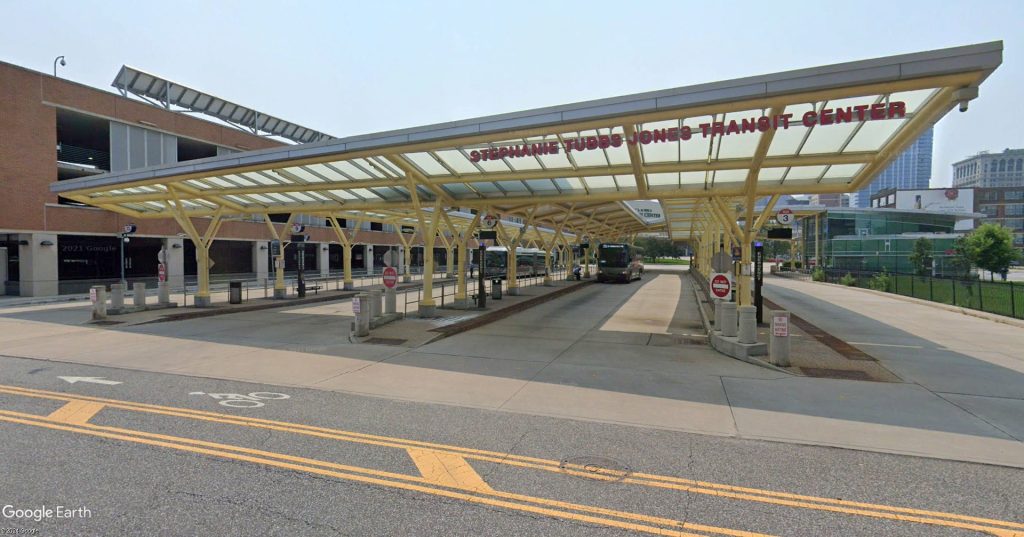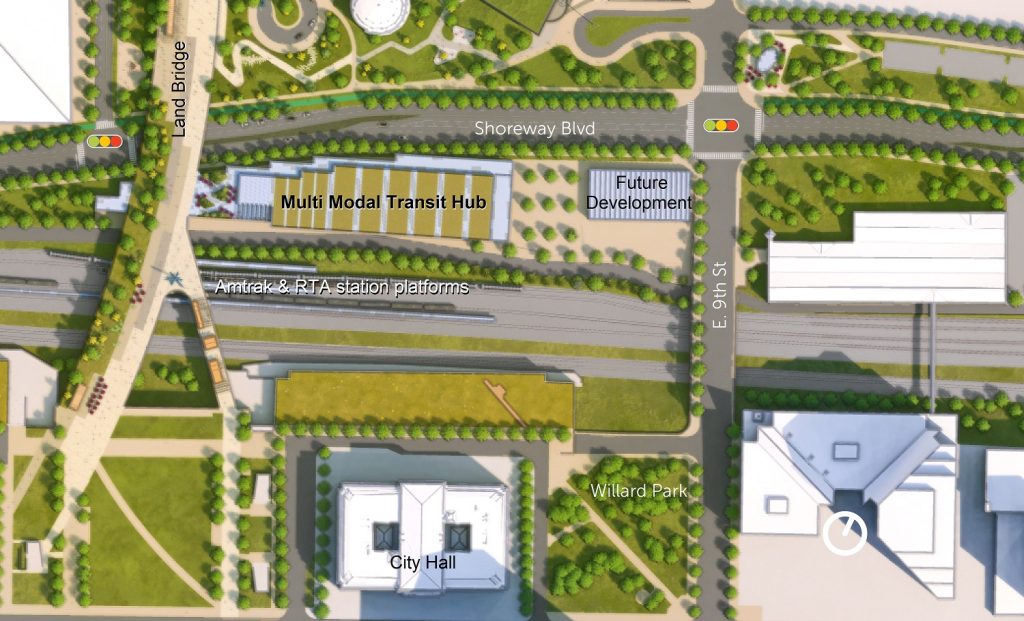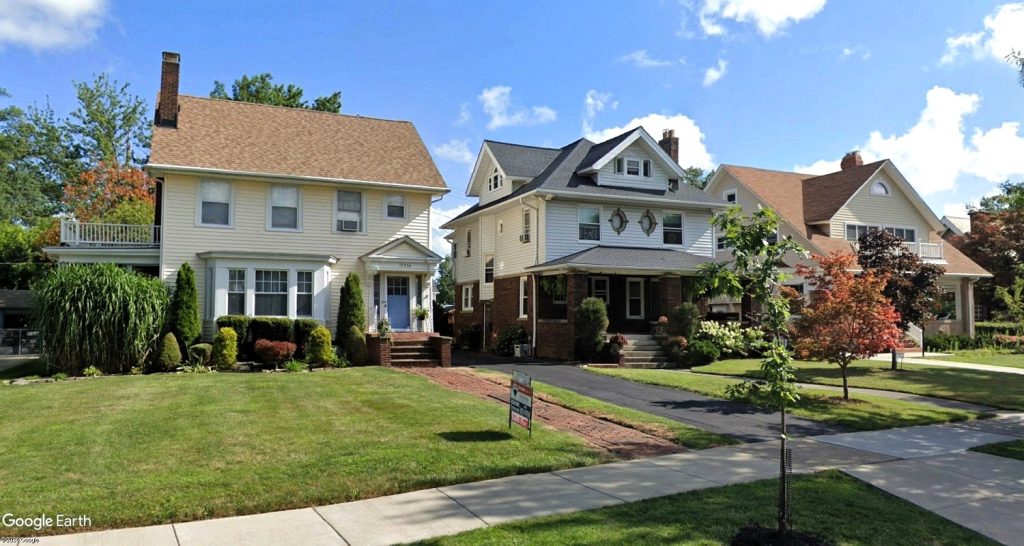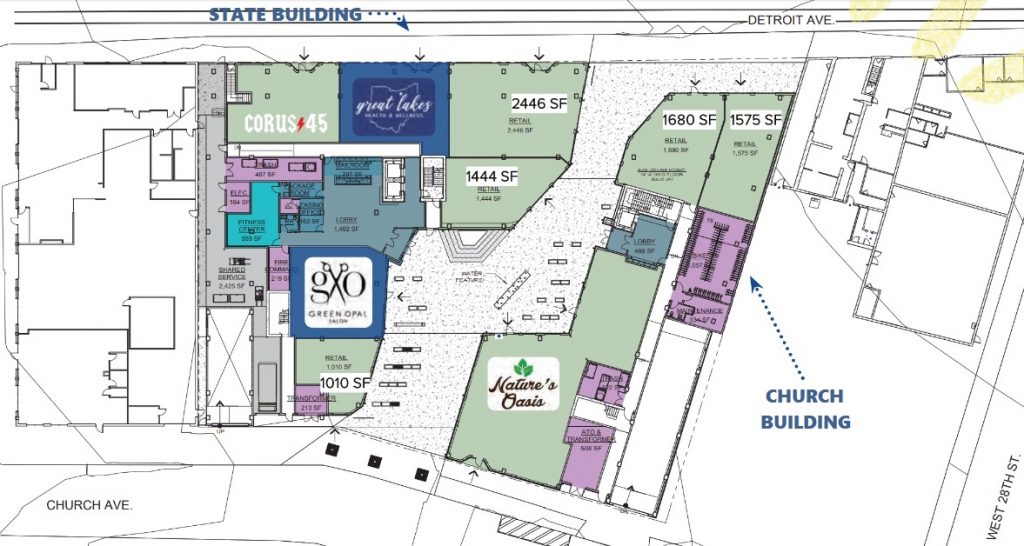
Likely to be the new home for the foreseeable future of Greyhound’s and Barons Bus’ Cleveland arrivals and departures is the Stephanie Tubbs Jones Transit Center. But the long-term station site may be a planned multi-modal transportation center on downtown’s lakefront (Google). CLICK IMAGES TO ENLARGE THEM.
New multimodal station may be long-term site
While city-to-city bus services have vacated traditional downtown stations for remote, curbside boarding locations in Ohio cities like Cincinnati, Columbus and Dayton, Cleveland travelers may be spared that treatment in a plan being worked out with the city. But city planners and advocates say the long-term station site may be a new multimodal transportation center linking all modes of intercity and intracity transportation elsewhere in Downtown Cleveland.
Greyhound and Greater Cleveland Regional Transit Authority (GCRTA) spokespersons confirmed to NEOtrans that Cleveland’s two intercity bus service providers — Greyhound and Barons Bus — are working out details on moving to GCRTA’s Stephanie Tubbs Jones (STJ) Transit Center, 2115 E. 22nd St., near Cleveland State University. The two bus service providerss combine for 30 buses arriving and departing Cleveland in a 24-hour period,
Dallas-based Greyhound and Brook Park-based Barons Bus will move from the 76-year-old landmark Greyhound station in Downtown Cleveland after Playhouse Square Foundation bought the Streamline Moderne building last week. The station will be repurposed as an entertainment and dining venue to expand the theater district northward. But a foundation spokesperson told NEOtrans that bus service won’t be moved out until a new location is found that works for Greyhound and the city.
“After close collaboration with the city of Cleveland and local officials, Greyhound can confirm our ongoing operations at the terminal situated at 1465 Chester Avenue as we continue working towards transitioning to our future location,” said Courtney Castaneda, senior manager of communication and events at Greyhound, in an e-mail to NEOtrans.
Last week, NEOtrans reported that the 2010-built STJ Transit Center was being considered by Greyhound and Barons Bus for its main Cleveland station and that a satellite stop was possible at the Puritas Red Line rapid transit station at West 150th Street and Interstate 71 in Cleveland’s West Park neighborhood. That would unite multiple modes — intercity bus, car parking and urban rail. GCRTA Public Information Officer Robert Fleig confirmed it this week.
“I do know that Barons Bus is completing due diligence to consider licensing a portion of the STJ Transit Center for inter-modal transit use with Greyhound as a sub-licensee,” Fleig said. “Puritas Station (4200 W. 150th St.) is no longer being considered as a primary location for inter-modal transfers.”
“We extend our appreciation to Playhouse Square, as the new owners of the property, for their partnership as we solidify our future plans,” Castaneda added. “Further details regarding our new location and transition timeline will be announced by the city and Greyhound once finalized.”
But the move wasn’t welcomed by the head of the Chaddick Institute for Metropolitan Development at DePaul University in Chicago. Chaddick has researched and documented the decline of intercity bus services for more than a decade.
“A move away from the station will make intercity trips more difficult for people who cannot or prefer not to drive. The station has an attractive waiting room and space to allow queues to form inside,” said Joe Schwieterman, director of the Chaddick Institute.
“An unappreciated problem resulting from Cleveland’s Greyhound station’s closing is that passengers making transfers will likely have to wait in more mundane conditions,” Schwieterman added. “The current station is within walking distance of many retained businesses. This is part of a disturbing national trend that has spelled doom for many Greyhound stations. State and federal governments have mostly watched from a distance as these important hubs are shuttered.”

Although travelers say Cleveland’s historic Greyhound station leaves a lot to be desired, it is much more comfortable and transit-accessible facility than bus stations in Cincinnati, Columbus and Dayton. Although the Cleveland’s station’s snack bar in the background closed at the start of the pandemic four years ago and hasn’t reopened (KJP).
Neither the Greyhound or GCRTA spokesperson was able to confirm details about whether the STJ Transit Center’s long-closed 2,000-square-foot heated waiting room and its restrooms would be reactivated for passenger use. Therefore, information was also not available about offering a potential cafe/snack bar like the one the Cleveland Greyhound station had until the pandemic hit, or the one Akron Metro Regional Transit Authority still has at its Robert K. Pfaff Transit Center in Downtown Akron.
“Intercity bus services like Greyhound can remain viable when operating from transit hubs, but the devil is in the details,” Schwieterman said. “Shortages of seating and lack of food and beverage options and poorly maintained restrooms can make trips more arduous.”
The Pfaff Transit Center is served by Akron city buses, Greyhound and Barons Bus services, plus Stark Area Regional Transit Authority buses to Canton, and Portage Area Regional Transit Authority buses to the city of Kent and Kent State University. All of those service providers also have bus services to Cleveland but are not united in a station facility to make transfers more understandable and convenient like Akron’s.
And that’s what transit advocates say they want, including uniting them with Amtrak intercity trains, GCRTA urban rail services and Laketrans buses. City officials and their design consultants have proposed such a facility as part of the evolving lakefront planning process — a 150,000-square-foot multimodal transit center next to a proposed land bridge linking the lakefront with the central business district.
“This plan aims to reconnect the city and the lake through multiple, meaningful connections back and forth,” said Lisa Switkin, a partner at design firm Field Operations.

Close-up of the city’s lakefront development masterplan released in October 2023, showing the proposed 150,000-square-foot multimodal transportation center where the current Amtrak station is located. It would combine two Waterfront Line rail transit stations and the Amtrak station into a single facility but, at this time, not include Greyhound or Barons Bus (FO).
Also in the city’s lakefront plan is a cruise ship terminal at the foot of West 3rd Street. The Port of Cleveland said it handled 49 port calls by cruise ships in 2023, up from 37 in 2022.
City officials were unwilling to comment publicly on the status of planning for the multimodal transit center or if Greyhound and Barons Bus services might be located there someday. They said they are focused on keeping the intercity bus services downtown in the near-term. In the recent past, they said Greyhound was unwilling to be part of the lakefront multimodal hub.
That’s surprising because Greyhound has shown an interest in co-locating with Amtrak wherever possible. In 2019, it relocated its Sandusky station to the Amtrak depot which is owned, operated and served by the Sandusky Transit System. Three years earlier, Greyhound moved its Toledo station to MLK Plaza owned by the Toledo Metropolitan Area Council of Governments and served by Amtrak trains and buses.
“While relocating Greyhound to the STJ Center is a good interim placeholder, the best long-term solution for improving regional mobility is a new multi-modal station downtown,” said Lakeshore Rail Alliance spokesman Stu Nicholson. “We encourage Greyhound, Barons Bus, Amtrak and the transit authorities in Cleveland, Akron, Lake County, Stark County and Portage County to co-locate a stop on their routes at a shared, convenient, safe and retailed big-city station. If so, such a facility could be used by as many people as those who visit Cleveland Browns Stadium during football season.”
Cleveland Browns home games drew 610,295 fans last year. According to rail and transit advocacy association All Aboard Ohio, prior to the pandemic, Amtrak, Greyhound/Barons Bus, Megabus, GCRTA Waterfront Line, and Downtown Cleveland-oriented routes to/from Akron, Canton, Kent and Lake County had 780,000 Downtown Cleveland boardings per year.
Megabus no longer serves Cleveland and ridership on the remaining modes have dropped since, except Cleveland’s Amtrak service which has returned to pre-pandemic levels, Amtrak data shows. There are nascent plans to expand Amtrak services to Cleveland but federal law requires states to sponsor Amtrak expansions, something which Ohio has refused to do for more than 50 years.
Nicholson didn’t specify where the downtown multimodal station should be, however. The Lakeshore Rail Alliance, which promotes expanding Amtrak service on the busy Chicago-New York City/Boston Lake Shore Limited route, has urged the city to conduct an alternatives analysis of locating the multimodal hub on the lakefront or at Tower City Center — formerly Cleveland Union Terminal and still the hub of GCRTA’s rail operations.
Dick Clough, executive board chair of the lakefront advocacy group Green Ribbon Coalition, Inc., had a third site in mind for Greyhound and Barons Bus that could be combined with Amtrak, all three GCRTA rail lines, plus many GCRTA and collar-county bus routes, and even the Cuyahoga Valley Scenic Railroad.
“The Tubbs Jones Transit Center seems like the perfect interim location until the multimodal is built but of course they are building the latter in the wrong location,” he said. “Get the transit center off the lakefront and built it on the Broadway Bluffs (near the Main Post Office). The lakefront is no place for an edifice complex.”
END





